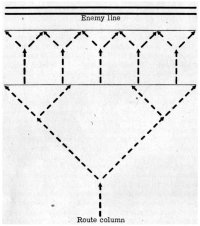![]() The Pacific War Online Encyclopedia
The Pacific War Online Encyclopedia
|
| Previous: Medium Bombers | Table of Contents | Next: Meiktila |

U.S. Army. Via ibiblio.org
The U.S. War Department defined a meeting engagement in 1941 as follows (FM 100-5):
A meeting engagement is a collision between two opposing forces more or less unprepared for battle. Ordinarily, the collision is caused by uncertainty or obscurity in the situation. This aspect is often present in the operations of small units and in situations where the means of reconnaissance have failed or are unable to operate.
The classical example of a meeting engagement is the Battle of Gettysburg, where a chance collision between a Confederate brigade foraging for supplies and a Union cavalry division on reconnaissance at a town of no particular strategic importance led to the decisive battle of the American Civil War. Both sides felt compelled to reinforce rather than withdraw, and both sides soon committed almost their entire strength to the battle.
Meeting engagements seem to hold an unusual fascination for military theorists, perhaps because no other kind of military engagement provides more scope for skillful maneuver and decisive action, and the meeting engagement was an important part of military doctrine in 1941. The Germans believed that the advantage in the meeting engagement (Begegnungsgefecht) lay with whichever side could more quickly organize for attack and thus deprive the other side of the initiative. The Japanese Army emphasized the meeting engagement as the ideal setting for the Japanese emphasis on swift offensive action and devoted more space to it in their field regulations than any other kind of combat: "The Imperial Army seeks to wage a short war to a quick and decisive conclusion. The meeting engagement conforms to this spirit and is to be sought whenever possible" (quoted in HJMF 1944). American doctrine of 1941 also emphasized rapid action to seize the initiative, but prescribed a relatively elaborate procedure for establishing advance command centers, deploying the main body behind the advance guard, and deploying the cavalry and artillery to support the attack. This suggests a lack of flesibility that could not have been much help in actual meeting engagements.
At the strategic level, the Guadalcanal campaign had many of the characteristics of a meeting engagement. Neither side had anticipated fighting in the tropical jungles of the South Pacific in their prewar planning. The Japanese seized Tulagi as a seaplane base to guard their advance on Port Moresby, and began construction of an airfield on Guadalcanal almost as an afterthought. King originally envisioned the Guadalcanal campaign as a kind of spoiling attack,
a limited offensive meant to keep the Japanese off-balance and keep
them from consolidating their defense perimeter before the arrival of
the massive American warship construction. However, both sides felt
compelled to reinforce until almost their entire strength was focused
on this one campaign. As a result, Guadalcanal became the turning point
of the war in the Pacific.
References
FM 100-5 (1941-5-22; accessed 2012-7-4)
Handbook on German Military Forces (1945-3-15; accesssed 2012-7-4)
Handbook on Japanese Military Forces (1944-9-15; accessed 2012-7-4)
The Pacific War Online Encyclopedia © 2012 by Kent G. Budge. Index